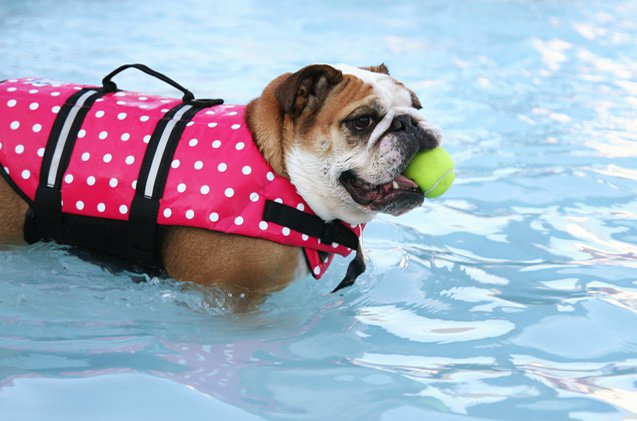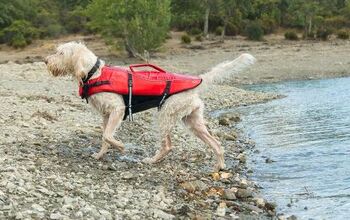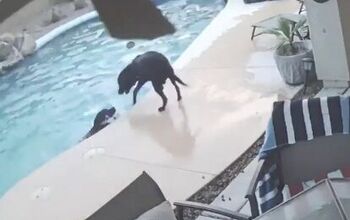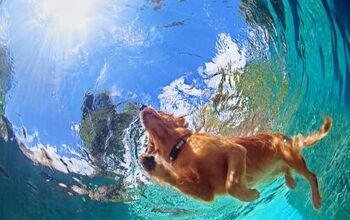10 Dog Breeds That Can’t Swim

As God is my witness, I thought all dogs could swim! Who wouldn’t? I mean, they named my beloved “dog paddle” swimming technique after pooches everywhere. So, I just assumed it was a natural instinct that applied to all dogs. But nope, as it turns out that assumption isn’t just incorrect, it’s downright dangerous. You’ve gotta be careful with these sorts of assumptions.
For me, it all changed a few years back when my niece’s Pug, Peanut, did a splashdown in my sister’s backyard pool. At first we thought his cute floundering was just an awkward dog paddle but within seconds we realized it was a genuine struggle and my sister jumped in (fully clothed, no less) to save the little guy. Don’t worry, he’s fine. Yes, it was frightening and a rude awakening.
The truth is that not all breeds can swim well at all. While an initial doggie paddle may look promising, some pooches can run into trouble pretty quickly and should never be anywhere close to deep water. Sad, but true. It’s something that we must all find a way to learn to live.
So how do you identify whether or not your doggo will be a super swimmer? Here are three tips to help identify if your pooch is not a natural paddler: 1) he has a large and heavy chest; 2) he has short legs; 3) he has a short muzzle (also known as brachycephalic). If your dog has any of those qualities, you should at the very least be reluctant to toss the pup into your pool.
If you would like a more detailed guide to identify pups that should be kept away from water, don’t worry. We’ve got it coming to you right now. Here are the top 10 dog breeds that are just not designed for swimming. Sadly, they will never be the furry Michael Phelps of your backyard. It doesn’t matter how much you want that to happen. It never will.
10. Pug
These little guys are built to be adorable, not to be swimmers. A brachycephalic breed of dog, this tiny pup’s short snout can cause shortness of breath which not only hinders his ability to swim for any length of time but makes it difficult for him to keep his muzzle above water. It’s a sad struggle to watch these pups in water. For flat-faced dogs to be able to keep their nose and mouth above water, they need to tilt their head upwards, causing their back end to tuck under their body and them to sink. They simply can’t hanlde it. So, providing your Pug with a life vest is imperative around pools. (Photo credit: klippel1/Depositphotos)
9. Dachshund
You wouldn’t guess that Dachshund’s would struggle in water just by looking at them like pugs, but appearances can be deceiving. Although this breed is relatively light-weight and his longer muzzle means he doesn’t run into the same water problems as a Pug or Bulldog, this breed’s short legs means he will never be a strong swimmer and will likely struggle to paddle for any length of time. Unfortunately, swimming is all in the legs and this lil’ pup’s stubby stumps can’t keep him afloat. Water sports should be contained to a sprinkler or a kiddy pool with water no higher than his shoulders. That said, they can even drown if they get tuckered out in shallow water. So always keep a close eye on your little guy when he’s in any amount of water. (Photo credit: vagawi/Flickr)
8. Maltese
While this small dog breed doesn’t carry the typical problem traits of non-swimmers with his lighter weight, smaller chest and full muzzle, he can experience challenges related to water play such as chills, arthritis and rheumatism. He is a sensitive little pup who has trouble adapting to the drastic change of environment that comes from plopping into water. To ensure all playtime is safe and fun for this mini pooch, it’s best to stick to dry land with games of fetch and catch. Thankfully there are still plenty of ways to play with this pup without getting wet. (Photo credit: Shek Graham/Flickr)
7. Bulldog
It’s pretty easy to size up a bulldog as being adverse to water play. This breed ticks all of the obvious non-swimmer boxes. His short muzzle means he is considered a brachycephalic dog. While his barrel chest, large head, and short legs mean that he will never be able to paddle fast enough to support his own weight. In fact many breeders and rescue groups will require a home visit to ensure any family swimming pool is safely fenced before letting your bring home a bulldog. If he is to be near water, pet parents should ensure he is always supervised and wearing a life vest. The good news is that he will look absolutely adorable in his little life vest. So that will be an easy safety requirement to follow. (Photo credit: Annette Shaff/Shutterstock)
6. Basset Hound
Unfortunately everyone’s favourite droopy dog isn’t built for swimming either. While this breed holds a record for possessing the world’s longest ears, they’re sadly not flotation devices and therefore offer no support should this big boy find himself in deep water. In fact, his large head, dense bone structure and disproportionately short legs mean he is incapable of keeping himself afloat for any length of time. Plus those lengthy ears that define the Basset Hound’s unique look can also be prone to waterborne infections. So for many reasons, this natural born tracker would do best as a landlubber. (Photo credit: Grégory Szkudlarek/Flickr)
5. Chow Chow
While we tend to consider larger dogs natural born swimmers, the Chow is an exception to this rule because of his deeper chest and shorter legs. The flatter muzzle can also cause him shortness of breath and his thick heavy coat can easily become waterlogged and weigh him down. Extra caution should be exercised with this breed and for pet parents with a pool or who enjoy water sports, a properly fitted life vest would be a good investment for your Chow. (Photo credit: Whitney H/Flickr)
4. Corgi
This sturdy little breed might have a longer muzzle but his dense body, large barrel chest, and short legs ensure that he they never be strong swimmers. While they love the water, it’s best to just let them wade chest-deep if they so desire or fill a kiddy pool during hotter weather and allow them to splash around. If you take them boating, a life vest is a must. They just can’t keep themselves afloat otherwise. (Photo credit: kent/Flickr)
3. Boxer
Though his long legs may make him look like swimming would be second nature, this breed runs into the same challenges as Boxers and Pugs: he is considered brachycephalic. His flatter face and shorter muzzle means he will struggle to keep his face and nose above water and may run into shortness of breath if left to swim for too long. Water activities should be kept to a romp on the shore, a run under the sprinkler or some playtime in a kiddy pool. Never a swim. (Photo credit: Tom Wood/Flickr)
While this athletic, spirited dog loves his exercise, his solid and dense muscle mass makes him heavier and not inclined to take up swimming. Add to this a head size and weight that tends to be disproportionate to that of his body and you’ll find that it can be very difficult for him to keep his head above water for any length of time. Best to tire him out on land! (Photo credit: Chris Stickley/Flickr)
1. Shih Tzu
Finally, there is no pooch less suited to swimming that the Shih-Tzu. Similar to the Maltese, this little guy can quickly catch a chill and although he may give it his best shot, swimming can be a struggle due to his tiny muzzle and small legs. His fuller coat can also become water-logged while swimming, weighing him down, covering his face, and making breathing difficult. And remember, tiny dogs can become frightened or nervous in open water, making the overall experience unpleasant to say the least. (Photo credit: Elenarts/Depositphoto)
How to Keep Your Dog Safe Whenever He’s Around Water
If your pooch isn’t one that is good at swimming, you will need to take extra precautions to keep him safe whenever he is near a body of water. That’s true whether you are spending time by a lake, at the beach, or in your backyard by your swimming pool. Any of these seemingly tranquil locations can quickly turn into horrifying death traps if your pup is suited to swimming. As mentioned in the intro, accidents can happen when you least expect them. Animals can even slip into pools, which could spell disaster, especially if no one is around to save your companion.
There are many steps that you can take to keep your dog safe around any body of water, especially in a controlled environment like a backyard with a swimming pool. All it takes is a little extra attention and care. You’re a pup parent. That behaviour should come naturally. First off, only let your dog out to play by the pool when someone is there to supervise. You will definitely want someone to be there to jump in and save him if he slips and falls into the water. That’s just common sense.
Adding a protective fence around your pool is another way to keep your dog away from the dangerous water. It’s pretty common as well. Just as you would use a fence to keep kids away from a pool, this strategy can work for dogs too. You can even place a cover over your pool whenever it isn’t being used. Just make sure that you choose one that allows rainwater to drain through the cover into the water underneath, as this is a good way to ensure large, hazardous puddles don’t form on the top of it.
Another step that you can take involves adding ramps or stairs to the pool so that, if your dog does fall in, he might have a chance to make his way out on his own. This doesn’t remove the requirement of having someone there to supervise him while he’s outside by the pool, but these tools can serve as additional safeguards. It at least provides you with a little peace of mind, even if it’s not a perfect solution.
Finally, it’s worth investing in a doggy lifejacket if you have a pup who isn’t suited to swimming, yet can’t resist the water. Whenever your dog is near the water, whether at home or in the great outdoors, put a canine lifejacket on him. A high-quality and well-fitting lifejacket can help him stay afloat in the event that he accidentally ends up in the water and can’t swim. (Note: even dogs that can swim could benefit from wearing a lifejacket, just in case anything goes wrong or if they get tired, for example.)
Finally, you should also consider taking a canine first aid class, or simply doing some research online, to learn how to perform CPR on your dog. That way, if an emergency were to occur, you’ll have the vital knowledge that will allow you to act fast. You will know how to quickly evaluate your pet’s breathing and pulse and you’ll know how to position your dog correctly to perform compressions and respiration without hurting him. Having this basic emergency safety knowledge could make a huge difference in any life or death scenario. It’s all to easy for these sorts of situations to spiral out of control, so a little research can go a long way in any emergency. Take the responsibility seriously. Sure, you may never need to use any of this knowledge, but this is very much a “better safe than sorry” situation.
Know Your Dog’s Breed and Needs
Ultimately, it’s important to know what your dog’s limitations are, based on his breed. While some pooches are natural-born swimmers, others have a lot of trouble once they’re in the water. That’s why having this information will allow you to take the appropriate steps towards keeping your pet safe by the water. Even if your dog is on this list and unsuited to swimming, that doesn’t mean that the pup won’t love the water and desperately try to swim whenever he has the opportunity. In fact, it’s almost guaranteed that will happen. So, it’s up to you as a proud and protective dog parent to be ready to jump in and take care of his safety. Thankfully, there are plenty of ways to do so and by simply seeking out this article, you’ve already taken your first steps.

Sharing space with three seriously judgy Schnoodles and a feline who prefers to be left alone. #LivingMyBestLife
More by Mary Simpson

































